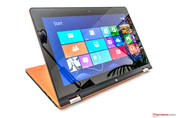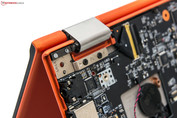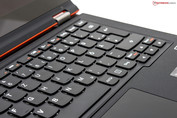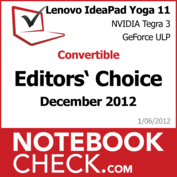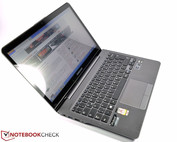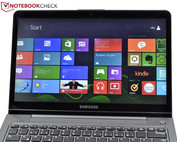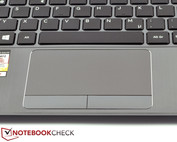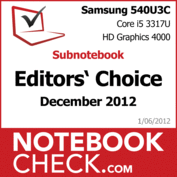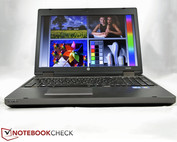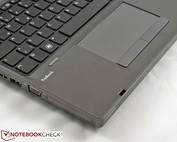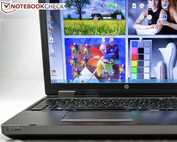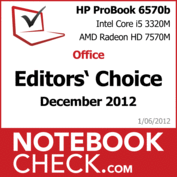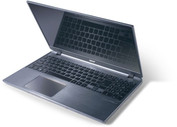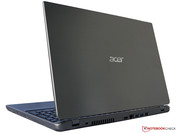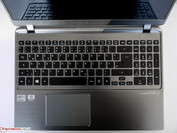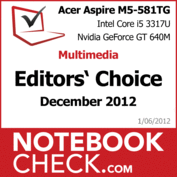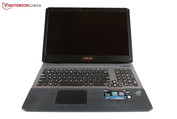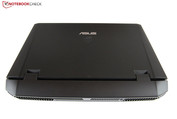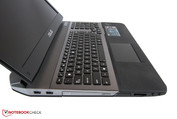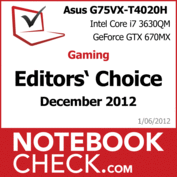Notebookcheck's Best of December 2012 - Notebooks
For the original German review, see here.
The reviewers were not inactive around Christmas. We reviewed 31 notebooks and numerous tablets and smartphones, which we elect separately: Best of December 2012 – Smartphones and Tablets. Looking back, which devices did we like most in December? We compare laptops of five categories and elect a winner in each.
Just like in November Windows convertibles are gaining ground. But, only Lenovo's IdeaPad Yoga 11 uses Windows RT. This is not surprising as it comes with a Tegra 3 SoC. Samsung's ATIV Smart PC and Acer's W510 are tablets which can turn into a clamshell notebook via Keyboard-Dock.
We again had a lot of subnotebooks under review in December. Lenovo's ThinkPad T430u is a special contender; because it comes with a GeForce GT 620M despite a low price (T series). With the Fujitsu Lifebook P702 the old laptop style returns for a moment: conventional input devices, a lot of interfaces, and a matte display. Unfortunately the wobbly case cannot keep up with today's stiff plastic chassis.
As office notebooks are demanded just before Christmas, we reviewed as many as nine devices. HP's ProBook 6570b, 6470b, and 4540s show professional ambitions, while the IdeaPad S405 and U510 turn out inferior. The S405 especially cannot meet the needs of its target group.
General-purpose laptops with big diagonals and decent to very good gaming performance have always been popular. We do not talk about gaming notebooks, as the graphics cards are mid-range. In December none of the devices proved to be especially good. Acer, HP and Samsung achieved a rating of 83% each. Many of our test samples are about on par, but not all of them, as the beaten devices from Asus and MSI prove.
Finally, two dissimilar gaming meteors competed, Asus' G75VX and MSI's GX60. Because of the AMD quad core, the most powerful Radeon, the HD 7970M performs vastly inferior. What did the "gaming specialists" think when they chose this configuration?
The only workstation of this month did not have any competitors: The Bullman E-Klasse 4 i7 17FHD (84%) is a mobile 17-inch CAD workstation equipped with a powerful Nvidia Quadro K3000M graphics card and Core i7-3940XM, the fastest mobile processor in Q3 2012.
Convertibles
Contenders:
- Lenovo IdeaPad Yoga 11 85%
- Samsung ATIV Smart PC XE500T1C 85%
- Acer Iconia W510 82%
- Lenovo ThinkPad Twist S230u 80%
After the 13-inch Yoga 13 (November) we reviewed the 11.6-incher. In being equipped with Tegra 3 and a 64 GB SSD it could be a typical tablet, but why does it cost nearly 800 Euros (~$1065)? Because it comes with Windows RT and features a clever folding mechanism. Its hinges allow the display to be turned by 360 degrees and afterwards the keyboard (deactivated in this mode) is the underside. We like its build quality, materials and runtime. But, the keyboard with poor feedback somewhat dampens our enthusiasm and the connectivity is minimalistic for a convertible. However, a tablet with three fully-fledged USB-ports is a nice thing, but, as a tablet, the Yoga 11 is inherently bulkier and heavier than its super-slim Android competition. The latter often feature higher resolutions. 1366x768 pixels no longer appear to be opportune for a premium device. But, we cannot complain about colors and brightness. By the way, Lenovo just introduced the Intel model called Yoga 11s at the CES 2013 in Las Vegas.
Samsung's ATIV Smart PC XE500T1C combines an Intel Atom Z2760 (designed for tablets) with fully-fledged Windows 8. Performance freaks won't appreciate this, while standard users will dislike the small 64 GB SSD, because only 32 GB are free on delivery. The keyboard dock does not belong to the best of its kind, but the mouse replacement and the keys are better than the Yoga's. The operating concept is appropriate, but docking and undocking could get annoying after a while.
Acer's Iconia Tablet W510 uses the same technology as the ATIV Smart PC, but is a little bit smaller (10-inch). HD resolution, IPS panel, Atom processor and 64 GB SSD are in a well built case. Unfortunately, the keyboard (tightly packed layout) and the touchpad (hangs, no multi-touch) perform poorly. The 13:35 h battery life could not be better and the brightness of nearly 300 cd/m² is also available on battery. The price of about 600 Euros (~$798) is lower than the ATIV Smart PC's, which features a built-in 4G-modem.
Lenovo's ThinkPad Twist ultrabook is a conventional convertible. Size and weight are typical for a 12.5-inch ultrabook. The Twist does not try to be a light and slim Windows tablet. First of all it is a subnotebook offering decent performance with optionally a classic tablet mode. The advantage of the Twist is its decent performance for Windows 8, the many interfaces typical for notebooks and the good keyboard (but, a poor touchpad). It is designed more for business use, but the short battery life of 3:16 hours (WiFi test) is disappointing.
Convertible notebook of December 2012: Lenovo IdeaPad Yoga 11
While the operating concept of the SmartPC, which achieved the same rating as the Yoga 11, is appropriate, we did not like its weak netbook hardware. If being handy and mobile are criteria, we would choose Windows RT and the Yoga 11. The folding wonder will find its fans as its possible fields of application in job, study or private life are enormous. Furthermore, using docking keys is only limited joy (Smart PC, Iconia W510). In our opinion, single unit devices are smarter solutions.
What we like
The concept of the 360 degree hinges and the good performance of the Nvidia SoC with Windows RT, along with the pleasant haptics of the case and the very good battery life.
What we'd like to see
The integrated UMTS module, a proper camera for taking pictures and a backlit keyboard.
What surprises us
The combination of a subnotebook with a tablet with considerable success, although Lenovo unfortunately hasn't been entirely triumphant.
The competition
Tablets with Windows RT: Microsoft Surface RT, Asus Vivo Tab RT TF600, the Samsung ATIV Tab or the Samsung ATIV Smart PC. Tablets with other operating systems include the Google Nexus 10 or the Apple iPad 4. Other subnotebooks and ultrabooks include: Asus VivoBook S200E, Asus Zenbook Prime UX21A, Acer Aspire V5-171-53314G50ass, Apple MacBook Air 11 Mid 2012 or needless to say the bigger Lenovo IdeaPad Yoga 13 with Windows 8.
Subnotebooks
Contenders:
- Lenovo ThinkPad T430u 85%
- Samsung 540U3C-A01DE 85%
- Dell XPS 13 84%
- Fujitsu Lifebook P702 84%
- Toshiba Portégé Z930-105 83%
- HP Envy TouchSmart 4-1102sg 82%
- Tarox Modula Ultrabook 74%
Lenovo's T series ThinkPads are known for their high standards and best everyday usability. The ThinkPad T430u is thinner than other ThinkPads (21 mm), but not more expensive (950 Euros, ~$1265). Performance freaks will appreciate its GeForce GT 620M and 128 GB SSD, even if the SSD cannot keep up with premium requirements. Battery Life (3:25 hours) and display (low contrast and brightness) are weak points.
Samsung's 13.3-inch 540U3C performs better with 5:40 hours battery life (Wi-Fi test) and touchscreen for a similar price (about 980 Euros, ~$1305). The build quality is decent and the input devices can keep up with the T430u's according to our rating. Unfortunately the display is equally poor and the SanDisk U100 SSD performs poorly when reading small blocks.
Long battery life, excellent build quality, high performance and a display with an at least acceptable contrast: because of its just acceptable keyboard, weak TN display (glossy, narrow viewing angles) and few interfaces Dell's XPS 13 does not achieve a very good in our rating. Devices for more than 1000 Euros (~$1331) entry-price should come with an excellent display.
Fujitsu's Lifebook P702 (just 1000 Euros, ~$1331) demonstrates that old design is not necessarily better than new. We liked the 12-incher's connectivity, maintainability, ergonomics and excellent keyboard (conventional, tapered keys). Undemanding users can live with its poor viewing angles. The wobbly base unit lowers the quality experience.
As an ultrabook Toshiba's Portégé Z930-105 is a small sham. Chassis and display are completely the same as the significantly cheaper Satellite Z930's with the same i5 CPU and same 128 GB SSD (900 Euros, ~$1198). The manufacturer demands a surcharge of 380 Euros (~$506) for the HDSPA modem incorporated into the Portégé. Nearly 1300 Euros (~$1731) is too much for only acceptable input devices (poor feedback) and a display with weak contrast and narrow viewing angles. But, 900 Euros (~$1198) for the Satellite, an extremely light, delicate ultrabook suitable for everyday use, is adequate.
Can HP's Envy TouchSmart 4-1102sg deliver the desired high-quality display? Unfortunately, not! Although the 14-incher comes with a capacitive touchscreen, viewing angles and brightness are below average and too bad for outdoor use (glossy). Too bad, the aluminum case, the high system performance and the decent battery life (5:45 hours, WiFi test) would have made it an excellent ultrabook.
An outsider and put back into the box with a rating of 74%? The same criteria as for Lenovo, Toshiba and HP also apply to the 14-incher of the German manufacturer Tarox. Unfortunately, the Modula Ultrabook disgruntles the reviewer everywhere: poor build quality, poor keyboard, rickety mouse replacement, poor-contrast, too dark, glossy display, high temperatures and system noise argue against a recommendation.
Subnotebook of December 2012: Samsung 540U3C-A01DE
Many ultrabooks come with inferior input devices, at least for prolific writers. Lenovo and Samsung demonstrate that typing can be comfortable on a slim elegant subnotebook. The T430u's battery life is simply too short for the ultrabook category. Both competitors should improve their displays. Convertibles have shown that contrast-rich IPS touch screens are possible. Why does Samsung especially use a poor screen in its touch ultrabook?
What we like
The brushed aluminum surfaces and the attractive inner values like the bright touchscreen.
What we'd like to see
For a street price of a whole 1000 Euros (~$1331), more than one of the three USB ports should be of the USB 3.0 variety. The display could have better contrast and black values. Also, since we are dealing with a high-mobility device, a Kensington Lock would be desirable.
What surprises us
The good heating management considering the space requirements is surprising. It is unfortunately also surprising that the useful VGA adapter was cut.
The competition
The Samsung 540U3C has its own predecessor, the Samsung 530U3C, to compete with. But since the current price of the latter lies only about 70 Euros (~$91) beneath the new version, the pros of this review device prevail, for example the SSD and the touchscreen. Further competition in the 1000 Euros (~$1331) segment is coming in droves: Acer Aspire S5, Apple MacBook Air 13 Mid 2012, Asus Zenbook Prime UX31A, Fujitsu Lifebook U772 or the Sony Vaio SV-T1312V1ES.
Office
Contenders:
- Fujitsu Lifebook S752 85%
- HP ProBook 6570b (B6P88EA) 85%
- HP ProBook 4540s-C4Z27EA 84%
- HP ProBook 6470b (B5W83AW) 84%
- Asus P45VJ-VO002X 83%
- Acer TravelMate P243-M 81%
- Lenovo IdeaPad S405 80%
- Lenovo IdeaPad U510 MBM62GE 80%
- Maxdata M-Book 4000 U G1 Select 78%
The 14-inch Lifebook S752 from Fujitsu looks a little bit bulky. However, neither beauty nor ultimate performance are important in this category. Instead, the Lifebook scores points with excellent ergonomics (waste heat, system noise), decent build quality, long battery life (6:27 hours) and a keyboard with strong feedback. Its plastic look and Core i3 are unremarkable. The hard drive is slow and only 2 GB RAM are unbalanced. This is too miserly for 700 Euros (~$932).
HP's ProBook 6570b achieved the same rating. Input devices and build quality are slightly better, but the matte display is striking in the office category: contrast of 1000:1 and brightness of 271 cd/m². As it is a TN panel the 1600x900 pixels screen has narrow viewing angles. The ergonomics is not as perfect as the Lifebook's, but it can score points in connectivity with a docking port and even a rare RS-232 (serial). Its biggest weakness is the short battery life of only 2:23 hours.
We continue with the ProBook 4540s, which is also a 15.6-incher. The 4xxx models are designed for ProBook novices, which have to live with lower resolution (HD), contrast (370:1) and without docking port. Our test sample with Core i3 and 7200 rpm hard drive costs 525 Euros (~$699) and delivers a decent office performance. Furthermore, HP did not save in the important aspects, keyboard, touchpad, stability of the case and heat management, which are of best ProBook quality.
ProBooks keep coming. Finally, the 14-inch sister model of the 6570b mentioned above faced up to our critical review. The 6470b does not feature a dedicated graphics card and the display only has HD (1366x768) resolution. Unfortunately, the user can not appreciate the vibrant colors and the decent brightness of the 6570b. Strange enough: Now the battery life of 4:23 hours is balanced. Important aspects like input devices, build quality, temperature and connectivity are largely on par with its 15.6-inch sister.
In regards of display the Asus P45VJ (14-inch) does not perform well (brightness: 196 c/m²). But, it costs significantly less than the 14-inch ProBook despite coming with a relatively powerful GeForce GT 635M. High-end business features like docking port, ExpressCard or eSATA/serial are missing. The stable plastic chassis appears rather consumer-oriented. The same is true for the input devices, which do not feature the ProBook's strong feedback. The battery life (4:43 hours) is alright. To summarize, the Asus P45VJ is a compromise for consumers who like to play computer games and are looking for a laptop for work and entertainment.
If you do not want to spend 800 Euros (~$1065) for a mobile computer, you'll maybe come across Acer's TravelMate P243-M for 550 Euros (~$732). The 14-inch laptop features a stable carbon/Mg-AI case, a decent keyboard (touchpad is not that good) and a battery life above four hours. The low brightness of the TFT on battery (130 cd/m²) is disappointing. The TravelMate is only an alternative if interfaces typical for the consumer range (no docking port) are sufficient.
Lenovo's IdeaPad S405 also wants to be cheap. It features an AMD Radeon HD 7600G and an AMD A-Series A8-4555M for 550 Euros (~$732). The performance of the 14-incher is very low and so is its energy consumption. This could have resulted in excellent battery runtimes, but due to its small 32 Wh battery only just three hours are possible. The plastic chassis twists, the keys spring and the brightness of the display is low. Not even the price is a buying criterion as comparable and partly better Core i3 alternatives cost the same.
The IdeaPad U510 from the same manufacturer is a 15.6-incher cheekily categorized as ultrabook. It's up to the user's discretion whether weight (2.2 kg) and height (24 mm with feet) still conform to this claim. In mobility it achieves 5 hours with Core i5 and HD 4000. Because of the relatively dark, reflective display, the U510 is rather an elegant indoor device. The aluminum look reminds one of the MacBook Pro series, but the flexibility of the base unit unmasks the imitator.
The Maxdata M-Book 4000 U G1 Select is a cheap ultrabook. The build quality is not disappointing and the matte, high-quality surfaces hardly show any weaknesses, but do also not achieve a top rank as an aluminum unibody would. We appreciate the long battery life of above six hours, but the matte, dark HD display cannot be used in the sun. For an interesting price Maxdata incorporates a genuine 128 GB SDD (no hybrid), which is unfortunately very slow. Unfortunately, it cannot keep up with high-end devices in ergonomics and display. Under load the M-Book 4000 U gets louder and warmer than other 14-inch ultrabooks.
Office notebook of December 2012: HP ProBook 6570b
Despite its short battery life we elect the ProBook 6570b and not the Lifebook S752, because we want to honor the decent HD+ panel after countless pale office displays. Too often this important user interface is just an ordinary TFT.
What we liked
The flawless manufacturing and high quality materials, as well as the successful design impresses throughout.
What we'd like to see
At a retail price of 1159 Euros (~$1530) we would have hoped for more than two USB 3.0 ports. Also, HP could have improved the battery life by allowing the integrated Intel HD Graphics 4000 chip to be used.
What surprises us
Despite the powerful components, the ProBook 6570b has very good temperature management. Considering the abundant features, a retail price of around 1000 Euros (~$1331) is very fair.
The competition
The HP ProBook 6570b-B6P88EA competes against the older ProBook 6560b. Among the other manufacturers: Acer TravelMate P653, Dell Latitude E5530, Vostro 3560, Lenovo ThinkPad Edge E530 and the Lenovo ThinkPad Edge E535.
Multimedia
Contenders:
- Acer Aspire M5-581TG 83%
- HP Envy m6-1101sg 83%
- Samsung 700Z5C-S04DE 83%
- HP dv7-7202eg 81%
- HP Pavilion g6-2200sg 80%
- Asus K53TK-SX114V 78%
- Asus K75VJ-TY102H 78%
- MSI CX61-i530M245 78%
Acer's Aspire Timeline Ultra M5-581TG can be described as a gaming-capable ultrabook with sufficient display size. The GeForce GT 640M (Kepler, newest chip generation) and Core i5 provide gaming power on-the-go. This is the first ultrabook that achieves a gaming rating of 86%. It even outperforms the HP Envy m6-1101sg (Radeon HD 7670M) with standard voltage Core i5. Despite its relatively low price of 800 Euros (~$1065) it achieves a high level in build quality (89%) and battery life (5 hours Wi-Fi test).
It's much more difficult for the HP Envy m6-1101sg with similar price to attract gamers. The 15-incher comes with HD 7670M and Core i5-3210M and does not score that well in keyboard and build quality, but performs better in ergonomics, while the battery runtime is about on par. Both competitors have a reflective TN display with narrow viewing angles. The Envy m6-1101sg somewhat excels with a contrast of 571:1.
Fast gaming and good looking? That's what Samsung thought when they updated their series 7 (model 700Z5C) with a powerful GeForce GT 640M. Together with a Core i7 it is slightly faster than the Aspire M5-581TG low voltage system. A lot of games can be stored on the 1000 GB hard drive, but poor contrast (144:1) and narrow viewing angles are outperformed by the HP Envy m6. This is a pity as the matte display features a comfortable 1600x900 pixel resolution. Customers expect a better color representation for 1400 Euros (~$1864). The series 9 models demonstrate how this can be accomplished with a matte IPS panel.
Do you demand an excellent display? If only the 700Z5C could change displays with the Envy dv7-7202eg. The 17-incher features a matte Full HD display, which is not only bright, but also achieves a contrast of 868:1. The TN panel performs above average in viewing angels and sRGB is nearly covered. In contrast, high system noise and relatively few interfaces devalue the dv7. Gamers will spurn the GeForce GT 630M, which is significantly slower than the 640M. Sometimes games do not even run smoothly in HD resolution. Here the GT 640M would have been much appreciated.
If you do not want to spend 1200 Euros (~$1598) for the Envy dv7, you might be interested in the HP Pavilion g6-2200sg. The 15.6-incher comes with a contrast-rich HD display and a gaming capable AMD Radeon HD 7670M for significantly less than 500 Euros (~$665). The good news from our test: its Pentium processor hardly limits gaming performance. Most of today's games run smoothly in native resolution. But, users have to live with a complicated GPU switch and a moderate build quality.
Same CPU, but less fun due to an AMD processor? This is our verdict on the 460 Euros (~$612) cheap Asus K53TK. The AMD A-Series A4-3305M slows down the Radeon HD 7670M in games. Games even run faster on HP's Pavilion g6-2200sg with a cheap Pentium. The display features decent contrast (595:1) and the battery keeps up with the Pavilion g6-2200s'.
The K series from Asus is also available in 17-inch. We reviewed the powerful model with GeForce GT 635M and Intel quad core (nearly 800 Euros, ~$1065). The gaming performance is slower than with GT 640M, but suffices high details in HD resolution. However, the native 1600x900 pixels screen is not much fun. Pale colors, low brightness and narrow viewing angles indicate that it is an ordinary display. The second 2.5-inch hard drive slot is a special feature.
If you want to save money, do it right. The MSI CX61 is available for barely 600 Euros (~$799) in virtual shops. The 15.6-incher houses a GeForce GT 635M and a Core i5-3210M. Its gaming performance is solid and similar to the Asus K75VJ-TY102H's. Not everyone will like the moderate build quality (input devices too) and the unstable chassis is not well manufactured. In addition, the short battery life, the poor display and the loud system noise under load downgrade the laptop.
Multimedia notebook of December 2012: Acer Aspire M5-581TG
One laptop must win. The same rating forces us to balance pros and cons. We elect Acer's Aspire M5-581TG as it combines decent build quality and high performance. Users will gladly live with high waste heat and loud system noise under load as this is the ultrabook currently running games fastest. None of the notebooks with a rating of 83% feature a really decent display. If you appreciate such a thing, consider the HP Envy dv7-7202eg.
What we like
High performance in a slim chassis and very good battery life under load.
What we'd like to see
A maintenance hatch allowing easy access to the hard drive, RAM and the mSATA SSD.
What surprises us
The thermal differences between this model and the Timeline Ultra M3-581TG.
The competition
HP Envy 6-1000sg, Asus S56CM, Acer Aspire TimelineU M3-581TG, Asus S500CA
14-inch alternatives: Samsung 530U4C, Acer Aspire TimelineU M5-481TG
Not ultrabooks, but also slim designs: Acer Aspire V5-571G (23 millimeters / 0.91 inches), Dell XPS 15z (25 millimeters / 0.98 inches)
Gaming
Contenders:
- Asus G75VX 87%
- MSI GX60 81%
The G75VX is the gaming meteor from Asus. The flagship now comes with Nvidia GeForce GTX 670MX. So, it is based on the newest Nvidia-Kepler architecture. Together with the i7-3630QM the 17.3-incher can run all games without problems - but not all of them in native Full HD resolution. Despite lacking Optimus, the battery life of three hours is remarkable. However, the 4.2 kg fireball needs a 74 Wh battery to accomplish this. We still have to criticize the suboptimal interface layout, but we like the high-quality case and the bright matte display with appropriate contrast (454:1). However, we expected an IPS panel for 1600 Euros (~$2130).
Rashly, MSI combined the most powerful AMD GPU with the weak AMD A-Series A10-4600M. This is the only way to keep the low price of 1200 Euros (~$1598). In terms of performance this mobile quad core is on par with a Core i3. Accordingly, the results of the gaming tests are sober. The A10 often slows down the Radeon HD 7970M so much that games can only run on mid-range level. That being said, the gentle reader can also buy a GT-640M system like the Acer Aspire M5-581TG above with better build quality (incl. input devices), weight on ultrabook level and low brightness for less than 900 Euros (~$1198). The matte Full HD display of the GX60 with good brightness, decent contrast and appropriate viewing angles is useful during games and work. The two mSATA-SSDs in RAID 0 are less impressive than expected. In reading small blocks the Raid-0 configuration performs poorly and worse than Solo SSDs (4K test: 8 MB/s).
Gaming notebook of December 2012: Asus G75VX-T4020H
According to the rating, the decision is easy. The G75VX profits from the MSI's fatal combination of strongest Radeon GPU with AMD quad core. The 17-incher from Asus kept its strength (ergonomics, input devices) and improved performance with the newest Kepler GPU. All things considered, there are no serious points of critique as even the matte Full HD display can convince us completely.
What we like
The casing's matte and awesomely cool surfaces.
What we'd like to see
Not all components can be accessed directly.
What surprises us
Asus still does not use Nvidia's Optimus technology.
The competition
17-inch desktop replacements featuring high-end graphics cards, such as Alienware's M17x R4, Deviltech's HellMachine, MSI's GT70, Medion's Erazer X7817, One's M73-2N, Samsung's 700G7C, Schenker's XMG P702 or Toshiba's Qosmio X870.


 Deutsch
Deutsch English
English Español
Español Français
Français Italiano
Italiano Nederlands
Nederlands Polski
Polski Português
Português Русский
Русский Türkçe
Türkçe Svenska
Svenska Chinese
Chinese Magyar
Magyar
